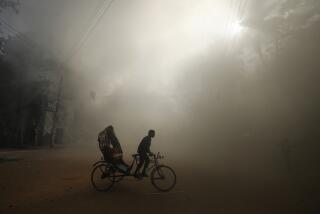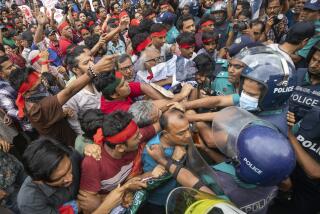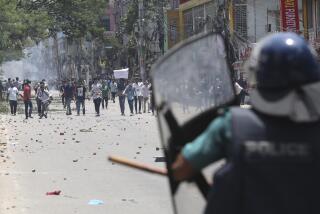150 Die as Troops Fire on Burmese : Protests Against Military Takeover Erupt in Clashes
- Share via
BANGKOK, Thailand — In a bloody imposition of military rule, more than 150 people were reported killed Monday when Burmese soldiers fired into crowds of angry demonstrators in sporadic clashes across Rangoon and in several provinces.
Accounts of the shootings remained confused and casualty reports varied widely. But the military command, which took power Sunday from the government of President Maung Maung, announced that soldiers shot at “violent and unruly mobs” in the Burmese capital. It said that 54 demonstrators were killed but admitted that its figures were incomplete.
Wire service reports from the chaotic capital, quoting estimates by diplomats and others, placed the number killed at 150 or more. One report said troops had been seen picking up dozens of bodies and taking them away in a truck.
10 Bodies at Hospital
Doctors at Rangoon General Hospital told reporters that at least 10 bodies had been brought in, along with 65 wounded people.
Some of the demonstrators fell in front of the U.S. Embassy when Burmese troops opened fire on an advancing throng and a group of bystanders.
“It wasn’t really fighting between the troops and the demonstrators,” embassy spokesman John Fredenburg told reporters. He said the soldiers fired into a marching column of up to 2,000 protesters who “were, as far as we could tell, unarmed and behaving in a peaceful manner.”
The troops then turned their guns on a group of about 100 young people standing in front of the embassy.
“When the firing died down . . . ,” Fredenburg said, “there were two people who appeared to have been killed and there was one wounded still lying in front of the embassy.”
U.S. Reviewing Aid
In Washington, the Reagan Administration said it is reviewing U.S. aid to Burma in the wake of the military coup and recurring violence. American aid this year totals about $14 million.
“In light of developments over the last 48 hours, we are reviewing our assistance programs to Burma . . . with an eye to whether they should be eliminated or changed in any way,” White House spokesman Marlin Fitzwater said.
“The United States is deeply concerned about and deplores the violence that has erupted once again in Burma,” Fitzwater said. “Whatever the country’s political problems, they cannot be solved by Burmese killing one another.”
The White House spokesman urged the military to stop shooting at demonstrators and protesters to refrain from provocative actions. And he called on military authorities “to enter into discussions with opposition leaders on arrangements for an early transition to multi-party democracy, which Burmese in overwhelming numbers are demanding and which the authorities say they are prepared to grant.”
The latest bloodshed was provoked by Sunday’s imposition of martial law by Gen. Saw Maung, the army chief of staff, and a junta of 18 top military officers. The junta, calling itself the Peace Restoration Committee, abolished government at all levels, from the presidency and Parliament down to the local councils.
‘Restore Law and Order’
Announcing the military takeover late Sunday afternoon, Saw Maung, who was defense minister in the government he ordered dissolved, said in a statement read over official Rangoon Radio that the armed forces intend to “restore law and order and peace and tranquility in the country.”
The junta imposed a nighttime curfew and banned gatherings of more than five people. Sunday night, troops moved into the capital in force.
After order is restored there will be democratic, multi-party elections, as promised Sept. 10 by the government of President Maung Maung, the announcement said. Late Monday there was still no word from members of the deposed government.
Opposition leaders Aung Gyi, Tin Oo and Aung San Suu Kyi issued a joint statement Monday declaring that they “could not contest an election under the current circumstances. . . . It is impossible.”
Ne Win Seen in Control
The statement suggested that former Gen. Ne Win, the Burmese strongman for 26 years, still holds ultimate control.
“We view the commander in chief’s assumption of all powers as no more than a technical transfer of power,” it said. “At this juncture we do not wish for any more bloodshed, particularly of innocent high school children.”
A similar call for restraint was issued by Min Ko Naing, a student leader. “Remain calm,” he was quoted as saying. “Do not confront the army.”
One of his aides told a reporter, “The orders are to remain tight today and tomorrow (Monday and Tuesday).”
Protesters Take to Street
But anti-government protesters, who had controlled the streets for more than a month and forced a series of concessions by Maung Maung, responded immediately to the imposition of military rule, and Sunday evening they moved back into the streets in defiance of the curfew.
They barricaded roads with felled trees and armed themselves with crude weapons--dart-firing slingshots and crossbows, gasoline bombs, machetes and, according to one report, pitchforks.
Numerous reports of gunfire were reported around midnight by Rangoon residents. At dawn, many of the barricades had been removed, apparently by soldiers. Monday morning the demonstrators marched again in numbers that defied the ban on gatherings.
Bloody Clashes Reported
According to unconfirmed media reports:
-- Fierce fighting took place in the blue-collar Okkalapa suburbs, where demonstrators burned three police stations last month and beheaded suspected government provocateurs. More than 150 people were reported killed in this melee alone.
-- More than 40 demonstrators and 17 soldiers were killed in a clash in the Bangalisu district of the city. Some of the demonstrators reportedly were seen taking weapons from fallen soldiers.
-- Two Buddhist monks were felled by bullets near the central Sule Pagoda, a venerated Buddhist shrine. Elsewhere in the capital, monks reportedly joined students in taking over a police station.
-- Two civilians were killed when soldiers in a passing car sprayed a suburban tea shop with gunfire.
‘Students Being Mowed Down’
Sein Win, the Associated Press correspondent in Rangoon, said that at mid-morning, he received a telephone call from a reporter who declared emotionally: “Many students are being mowed down. Can’t anything be done?” Sein Win, who was jailed by the government when demonstrations began in early August, said the reporter broke off in tears.
The shooting in Rangoon subsided by early afternoon, and there were no reports of violence through the rest of the day and into the evening. But there were unconfirmed reports of shooting in the northern city of Mandalay.
Junta commander Saw Maung is a hard-line, longtime associate of Sein Lwin, the former secret police chief who was president for 17 violent days in late July and early August after Ne Win resigned as head of the Burma Socialist Program Party.
According to a Western diplomat in Bangkok, who began a study of the 59-year-old general when he was appointed defense minister by Sein Lwin, Saw Maung is an “inflexible militarist” known for his loyalty first to Ne Win and secondly to the military-dominated party formed by the 77-year-old strongman after he took power in a 1962 coup.
The diplomat said that Saw Maung, a native of Mandalay, had moved several Mandalay-based military units down to Rangoon in recent weeks, presumably banking on their loyalty. Over the past month, as the Maung Maung government backtracked in the face of massive protests, some small-scale defections of enlisted men took place in Rangoon.
More to Read
Sign up for Essential California
The most important California stories and recommendations in your inbox every morning.
You may occasionally receive promotional content from the Los Angeles Times.










